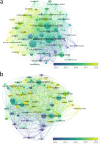A comprehensive review of domestic-open waste burning: recent trends, methodology comparison, and factors assessment
- PMID: 35615496
- PMCID: PMC9122483
- DOI: 10.1007/s10163-022-01430-9
A comprehensive review of domestic-open waste burning: recent trends, methodology comparison, and factors assessment
Abstract
Open burning is a waste management practice performed by many people worldwide, especially in developing countries. Lack of detailed data of open burning practices may lead to a misinterpretation during data analysis, especially when estimating global/local emissions and assessing risks. This study presents a comprehensive review of current research trends, methodological assessments, and factors behind open waste burning practices from published literature. This review used systematic methods such as PRISMA 2020 methodology, a bibliometric approach, and qualitative content analysis to determine and assess 84 articles related to open burning. The results show that environmental risks and emission factors related to open burning incidents at the landfill or residential level are preferable topics that will be rising in the years to come. Coupling methods such as a transect-based approach with a questionnaire survey and mobile-static plume sampling to determine the activities and incidents as baseline data for risk assessment will help researchers gain a robust dataset of open burning emission inventory. In addition, it was found that environmental knowledge and awareness levels influence open burning practices, thereby opening up opportunities for future research.
Supplementary information: The online version contains supplementary material available at 10.1007/s10163-022-01430-9.
Keywords: Developing countries; Emission estimation; Environmental monitoring; Open waste burning; Waste management.
© Springer Japan KK, part of Springer Nature 2022.
Conflict of interest statement
Conflict of interestThere is no conflict of interest exist.
Figures
References
-
- Kristanto GA, Koven W. Estimating greenhouse gas emissions from municipal solid waste management in Depok Indonesia. City Environ Interact. 2019;4:100027. doi: 10.1016/j.cacint.2020.100027. - DOI
-
- Kumar S, Aggarwal SG, Sarangi B, Malherbe J, Barre JPG, Berail S, Séby F, Donard OFX. Understanding the influence of open-waste burning on urban aerosols using metal tracers and lead isotopic composition. Aerosol Air Qual Res. 2018;18:2433–2446. doi: 10.4209/aaqr.2017.11.0510. - DOI
Publication types
LinkOut - more resources
Full Text Sources



